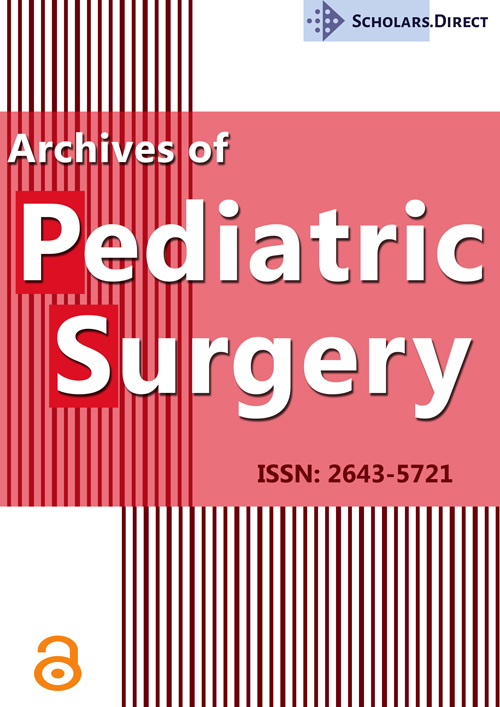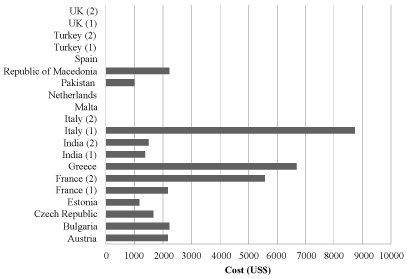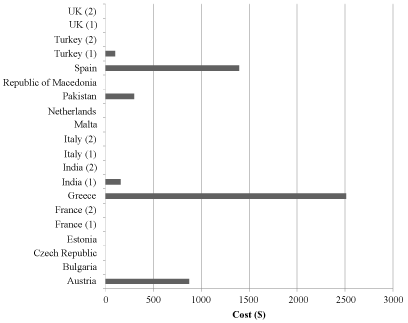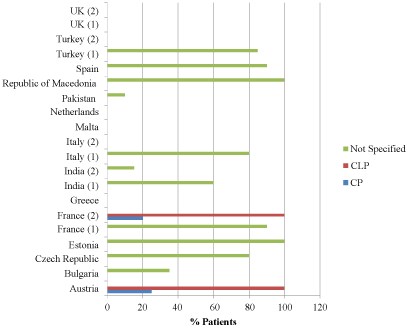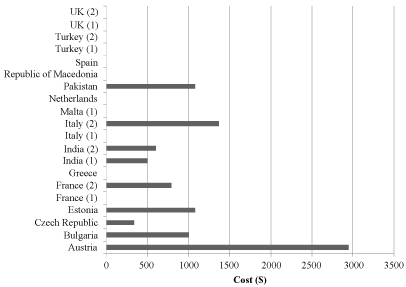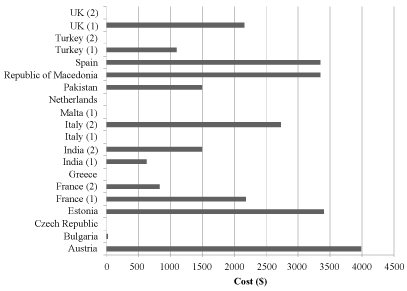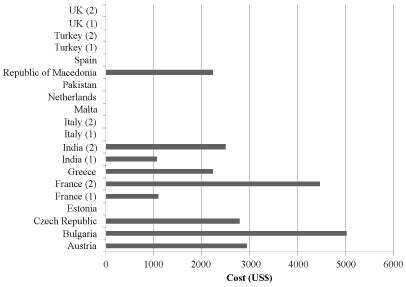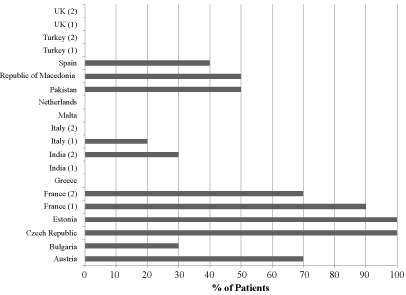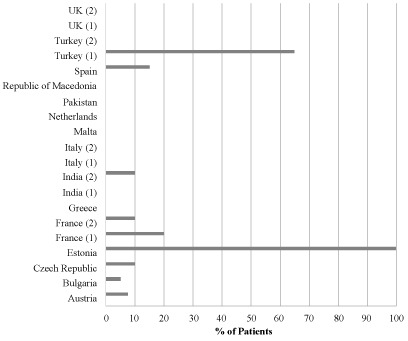International Knowledge of Direct Costs of Cleft Lip and Palate Treatment
Abstract
Background
Cleft lip and palate is a common developmental defect, however limited up to date information is available on the costs of treatment. This is important for national distribution of funds, developing cost effective patient pathways, and informing patients and their families of potential financial implications.
Methods
A questionnaire was developed and sent to experts in cleft lip and palate treatment via the European Cleft Gateway and to those who responded positively to a preliminary survey as part of the Global Epidemiology, Aetiology and Prevention Task Force. This questionnaire aimed to ascertain direct costs for pre-surgical orthopaedics, surgical repair, Speech and Language Therapy (SLT), orthodontics, and orthognathic surgery in different cleft centres. Respondents were also asked to advise on sources of funding and the percentage of patients who receive SLT, orthodontics and orthognathic surgery. Indirect costs were out of the scope of this research.
Results
Limited knowledge was evident from the twenty responses received, with the majority relating to European centres. However, from the information received, a direct cost of cleft treatment was estimated as $10,000-13,000 in European countries (where state/state health insurance is the most common source of funding) and $3,000-5,000 in India (where patient and charity organisations fund treatment).
Conclusion
Further work is required to gain homogenous data on the cost of cleft treatment internationally to allow cleft pathways to become more cost effective and to inform patients on costs where treatment is not funded by the state or private health insurance.
Keywords
Direct, Costs, Expenditure, Cleft
Abbreviations
CL/P: Cleft Lip with or without Cleft Palate; DALY: Daily-Adjusted Life Year; WHO: World Health Organization; CEA: Cost-effectiveness Analysis; NGOs: Non-Government Organisations; NAM: Nasoalveolar Molding; GPP: Gingivoperiosteoplasty; PSO: Pre-Surgical Orthopaedics; CL: Cleft Lip; CP: Cleft Palate; SLT: Speech and Language Therapy; CCC: Comprehensive Care Centre
Introduction
Cleft Lip with or without Cleft Palate (CL/P) is one of the most prevalent congenital deformities globally, commonly quoted between 1 in 500 to 1000 births [1]. The results of previous studies indicate that CL/P surgery, based on currently accepted international criteria, is highly cost-effective [2]. The cost per Daily-Adjusted Life Year (DALY) averted for CL/CP surgery is relatively small and within the range of cost-effectiveness defined by the World Health Organization (WHO) and the World Bank Commission on Macroeconomics and Health [3]. Cost-Effectiveness Analysis (CEA) is increasingly important in decision-making for public health resource allocation in all societies, whether rich or poor [4] and is in line with the WHO's strategy called Choosing Interventions that Are Cost-Effective (WHO-CHOICE). Furthermore, in healthcare systems that the patient bears the cost of treatment, this information is vital for allowing financial planning and giving families knowledge of aspects of treatment where external assistance may be required to cover costs. In India, Southeast Asia and sub-Saharan Africa, the prohibitive perceived cost of care may be a factor that contributes to the high rates of infant mortality [5].
To investigate the information that is currently available on the cost of cleft care, a structured review was carried out using PubMed, with additional searches of reference lists, with the search terms: "cleft lip", "cleft palate" and "expenditure", which identified 22 papers. Subsequently, using the following inclusion/exclusion criteria, 13 studies were analysed for further information on the cost of cleft treatment.
• Inclusion criteria: Presented either direct costs, indirect costs or a combination of these for cleft lip, cleft palate or cleft lip with or without cleft palate.
• Exclusion criteria: No new costs presented and cleft lip and/or palate costs combined with other craniofacial conditions. Research with total costs from Non-Government Organisation (NGOs) mission models were also excluded as no follow up care is provided and thus do not represent the true cost of cleft treatment.
The results of the structured review are summarised in Table 1. Waitzman, et al. [6] reports that in California in 1988 the direct cost per individual CLP for one year was $11,000 whilst indirect costs were $73,125. For Californian patients in 1992, Waitzman, et al. [7] advise that the total cost per year in California is approximately $697 million, with direct costs of $117 million and indirect costs of $599 million, although the number of patients included in their calculations is unclear. They also advise the cost per new diagnosis of CL/P is $101,000 [7]. Harris and James [8] used these figures to estimate the lifetime cost of cleft treatment as $1,045,695-$93,593,084, depending on the State that the patient was born in. A more recent study from the United States estimates the total cost of all hospital stays for patients with a cleft palate alone in 2004 as $15,506,700, whilst those born with CLP as $27,155,800 [9], however as professional fees were not included, this is likely an underestimation.
Others have used costs from insurance companies, however as these are reimbursement rates; they likely do not represent true costs. Cassell, et al. [10] reported the reimbursement of Medicaid patients in Northern California born between 1995 and 2002 as $1,272,094 (CL), $11,120,982 (CP) and $13,313,256 (CLP), whilst Boulet, et al. [11] reported MarketScan reimbursement rates in 2004 as $15,270 (total mean cost per patients up to 10-years-old). Individually, cleft lip reimbursement rates were approximately $11,500 per patient, cleft palate cost approximately $16,000 per patient and CLP cost approximately $15,500 per patient. Although it is difficult to interpret exact figures from the paper as this is represented in graphical form only, it appears that CP was more expensive to treat than CLP.
Studies from out with the United States are limited. Alkire, et al. [12] and Hackenburg, et al. [13] report costs from Indian populations treated by Operation Smile in their Comprehensive Cleft Care Centre in Guwahati as $2,745,000 (total direct cost for 2012) and $3,148,364.75 (for 24 months between 2011 and 2013) respectively. It is difficult however to ascertain a cost per case where total costs only are presented. Nagengash, et al. [14] advised the cost per surgery at the centre was $677 between 2012 and 2013. These studies also attempt to calculate the cost effectiveness of cleft care using Daily Adjusted Life Years (DALYs). This calculation demonstrates the number of years that a patient would lose due to morbidity or mortality, with one DALY equalling to one year that the patient would suffer from less than full health. They report a cost effectiveness of $189.81/DALY averted for a Comprehensive Care Centre (CCC) model [13] and indirect costs using Value of Statistical Life (VSL) to convert DALYs as $32 million to $116 million [12]. Furthermore, Corlew [15] reports from Nepal using the VSL approach that repairing a CL added $56,919 to $143,363 to a patient's lifetime income whilst repairing a CP added $152,372 to $375,412 and Alkire, et al. [16] estimate indirect costs using the VSL approach as $5.4 billion to $9.7 billion in Sub-Saharan Africa.
Further studies have assessed the cost of Pre-Surgical Orthopaedics (PSO). Pfeifer, et al. [17] advise that the direct cost associated with the correction of a unilateral CLP with a secondary bone graft was $22,744 in 1985-1988, compared to $19,745 for treatment with Nasoalveolar Molding (NAM) and Gingivoperiosteoplasty (GPP). This suggests that PSO is more cost-effective; however, this study is out-dated and does not consider indirect costs (including the burden of multiple appointments), adjunctive care, or the possible need for orthognathic surgery in the future. A further study from the Netherlands provides conflicting results to that of Pfeifer, et al. [17] as they advised that the direct cost of cleft repair with PSO is $852 (indirect cost $359) and without PSO is $304 (indirect cost $209) [18]. However, again this does not include long-term adjunctive care.
Unfortunately, little data was available on the majority of countries worldwide, whilst the heterogeneity of the results presented in published literature meant a meta-analysis was not possible. It is likely that many of the studies underestimate costs, and provide limited information on costs due to:
1. Lack of subphenotyping or separating Cleft Lip (CL), Cleft Palate (CP) and CL/P.
2. Not separating syndromic and non-syndromic patients.
3. Omitting details on the costs included or omitting certain direct or indirect costs.
4. Lack of detail on the type of pre-surgical orthopaedics and the surgery performed as this can affect the cost of treatment [17,18].
5. Not considering lifetime costs or costs for individual patients.
6. No mention of costs associated with a range of other cleft related specialties.
Wehby and Cassell [19] support these findings, and suggest that further research to calculate the cost of an orofacial cleft is required. Berk and Marazita [20] also agree that the most commonly quoted research in this field likely underestimates the true financial burden generated from cleft care. It is therefore essential that further research is carried out that allows the costs of cleft treatment to be calculated accurately in different healthcare models to subsequently allow for accurate cost effectiveness analysis on the benefits of multidisciplinary cleft care.
This research attempted to gain more information on what is known about the direct costs of cleft treatment from individuals who are actively involved in cleft palate treatment and research, with the aim of ascertaining how much information is available and adding to the current literature. Indirect costs were out with the scope of this paper and are the subject of further work. In order to calculate the total cost of cleft care, it is essential that indirect costs be calculated in future.
Methods
Questionnaire
A questionnaire was developed using Google Forms [https://docs.google.com/forms/] to establish:
• Whether the respondent has any knowledge of the direct cost of cleft treatment in their centre.
• The direct costs of Pre-Surgical Orthopaedics (PSOs), surgical procedures, Speech and Language Therapy (SLT), orthodontics, and orthognathic treatment.
• Whether the patient, private health insurance, the state or multiple sources pay the costs of the treatments listed above.
• The percentage of patients who receive treatment for each of the treatment modalities listed above.
Respondents were asked to separate their costs for CL, CP and CLP where possible and indicate "unknown" to any costs they were unsure of. They were also asked to provide the year for which their figures corresponded so that accurate exchange rates could be used to calculate in US$. All costs were converted to US dollars for 1st June of the year quoted by the respondent [http://www.xe.com]. Where no year was quoted, this was taken as 1st June 2016.
Sample
The questionnaire was sent to all members of the European Cleft Gateway, with a follow up email sent one month later to elicit more responses. It was also sent as a follow up survey to respondents who had responded positively to a preliminary survey as part of the Global Epidemiology, Aetiology and Prevention Task Force.
Data analysis
Data manipulation was minimal. Where costs were given as a range, the mean was taken of the two figures. Where SLT costs were given per session, per hour or per year, a total cost was estimated by assuming an average total treatment time of one monthly one hour long session per year for three years due to the fact that the aim of SLT is to normalise speech by school age [21]. Where a cost for orthodontic treatment was given per year, an estimated timeframe of 2.5 years was used to calculate a total cost. Data analysis included frequency distribution and cross-tabulation in Microsoft Excel.
Results
Twenty responses were received. The countries from which responses were received are as follows: Austria, Bulgaria, Czech Republic, Estonia, France (2 respondents), Greece, India (2 respondents), Italy (2 respondents), Malta, Netherlands, Pakistan, Republic of Macedonia, Spain, Turkey (2 respondents), and UK (2 respondents). Of these respondents, 80% were aware of the costs of cleft treatment and thus completed as much of the remaining questionnaire as possible.
Direct costs of treatment of cleft patients
There is a large range of surgical costs, from $450-1000 in Pakistan to $8729 in Italy (Figure 1a and Table 2). The respondent from Austria advised that surgery alone costs approximately $2182 thus this was included in this research as such. They also however gave the cost of overall treatment as $8510 for CL, $8510 for CP and $10,911 for CLP. There also appears to be a difference in the cost of pre-surgical orthopaedics from $100 in Turkey to $2512 in Greece (Figure 1b and Table 2). However, it does not appear to be used routinely by the majority of the countries that responded to the survey.
The cost of SLT (Figure 1c and Table 2) appears to be less readily available, with 12 respondents unable to provide a cost for their centre. Of the eight responses, costs were displayed in varying forms from cost per hour, per session, per year or not specified thus it is difficult to directly compare these between countries. Although the cost per session appears to be relatively consistent from $13-30 per session, the yearly cost differed with the greatest difference between India ($200) and Austria ($982).
The cost of orthodontic treatment appears to be relatively well known with 13 respondents able to give a cost for treatment (Figure 1d and Table 2). Again the costs appear to differ depending on the country with treatment ranging from $22 in Bulgaria to $3983 in Austria. This is a reporting error, as the costs of materials alone would cost more than $22. The cost of orthognathic treatment appears to be more consistent with a mean cost of $2705 for the countries who responded (Figure 1e and Table 2). There was however still a range of costs with largest difference between India ($1061) and Bulgaria ($5024).
It is not possible to calculate the total cost of cleft treatment for the majority of countries that responded due to lack of data; however an estimated cost of $10,000-13,000 for European countries and $3,000-5,000 for developing countries could be suggested (Table 2).
Sources of funding for direct treatment costs
The sources of costs of cleft treatment are summarised in Table 3. It appears that there are substantial differences in the methods of payments between countries. Where there are multiple respondents for one country, all responses have been presented. However, in general, the state or state health insurance covers most of the cost of surgery in European countries, while the patient covers some or all of the cost of the supportive services. In the non-European countries however, it appears that charity organisations are a large source of funding for surgery and the supportive treatments, thus reducing the burden on patients and their families.
Percentage of patients that receive supportive treatments
There appears to be a large difference in the number of patients who receive SLT from 20% in Italy to 100% in Estonia and Czech Republic (Figure 2a). This difference is consistent with the findings for orthodontics with a range of 10% (Estonia) to 100% (multiple countries) (Figure 2b). This may be a misunderstanding of the question asked as it is unlikely that all CL patients would require SLT. Where information was given for CP and CLP separately, 100% of patients with CLP receive orthodontics, whilst only 20-25% of patients with CP receive treatment. This may explain the difference in figures where phenotype was not specified. There was also a large range of figures given for the percentage of patients who receive orthognathic surgery; however the majority of respondents indicated around 10% of patients receive this treatment (Figure 2c). None of the respondents however were able to give figures for CP and CLP separately.
Evaluation of adjuncts to surgery
Only six respondents indicated a cost for pre-surgical orthopaedics, with three stating that this is not used in their centre and eleven not providing information. With the exception of Estonia, who reported that they do not use pre-surgical orthopaedics, and provide SLT, orthodontics and orthognathic surgery for 100% of patients, there did not seem to be any association between the use of pre-surgical orthopaedics and the increase or reduction in further treatment with SLT, orthodontics or orthognathic surgery. There was no obvious decrease in surgical costs with the use of pre-surgical orthopaedics (Table 4). There does not seem to be any obvious cause for a higher or lower percentage of patients who are treated by SLT, orthodontics or orthognathic surgery (Table 5, Table 6 and Table 7). However, this is difficult to assess with certainty due to the small number of responses.
Discussion
The relatively small number of positive responses and the lack of detail highlights that the little is known about the cost of cleft treatment worldwide. Information appears to be more available for European countries, whilst information on developing countries is limited. This is in agreement with the information found by Listl, et al. [22] when looking at dental disease. However, knowledge on costs in the developing world is of great importance. In the developing world, because of serious mortality and morbidity issues in conditions where access to services are readily treatable [5,23] there is a great need to improve access to essential and life-saving services. Only 4% of the world's surgical procedures are performed in countries with a per capita health expenditure of less than $100, even though these countries constitute 35% of the world's population [24]. Although some international NGOs provide specialized clinical services, such as CL/CP surgery, most patients in the developing world still confront insurmountable barriers to access such care. The costs of hospitalization and surgery plus accompanying travel and accommodation [2] is a significant challenge for poor patients, especially those living in isolated rural areas, and this undoubtedly contributes to the higher mortality rates.
With the information supplied, it is not possible to accurately calculate the total direct cost for cleft treatment, however with the figures presented direct treatment costs of $10,000-$13,000 per patient could be estimated for European countries and approximately $4,000 per patient for an Indian population where surgical intervention, SLT, orthodontics and orthognathic surgery is provided. These costs are similar to those quoted in the literature [6,11].
Differences in the use of pre-surgical orthopaedics
As different techniques can be employed for pre-surgical orthopaedics (ranging from lip strapping to feeding plate to PSO combined with naso-alveolar moulding), this may explain some of the differences in costs between countries. Its use is controversial, with supporters advising that the technique results in substantial cost savings as a secondary alveolar bone graft can be avoided [17] and nasal symmetry is improved [25]. Others believe that current evidence suggests there is limited long- and short-term effectiveness [26]. There did not seem to be any obvious reduction in surgical costs with the use of pre-surgical orthopaedics or reduction in SLT, orthodontics or orthognathic surgery. However, due to the lack of responses, it is not possible to offer a definitive opinion on the cost effectiveness of this technique.
Differences in primary surgical treatment
There is a large range of costs for surgical cleft treatment, with little information provided for phenotypes individually. Where this information is available, CL and CP appear to have similar direct surgical costs, whilst CLP costs more to treat. It could therefore be hypothesized that some of the differences in costs between countries may be due to quoting costs for treating different phenotypes. Furthermore, it is acknowledged by one respondent that their figures do not include prices of hospitalization, consultations or professional fees. This highlights likely heterogeneity between quoted costs. Furthermore, it appears this treatment is mostly funded by the state or state health insurance in European countries, whilst the non-European countries advised that charity organisations subsidise patient costs.
Differences in supportive treatments
SLT
The cost was similar per session/hour in the countries where information was provided; however, where costs were given per session or per hour, assumptions had to be made to calculate a total cost. As respondents did not provide this information and the authors could find no published data indicating average SLT treatment length, it may highlight that in most countries, the average number of visits for SLT in cleft patients may not be nationally documented. In Austria, it was estimated that 20-30 sessions are likely required per year and it would be interesting to compare this with other countries when information is available, alongside comparing the number of visits for private patients and state funded patients. The difference in the percentage of patients receiving SLT in each country was varied, which may reflect poor access to care, the impact of sources of funding or the severity of clefts in the countries that responded.
Orthodontics
A range of costs is quoted, which may be explained by different materials, the salaries of providers or length of treatment. It is important in future studies that the length of treatment is addressed in order to compare costs more reliably. The respondent from Bulgaria quoted a cost of $22, which is not possible and thus highlights the possibility of reporting error in the figures given. Orthodontics appears to be more prevalent in the European countries, which may be due to access to care or the type of clefts treated.
Orthognathic surgery
With the exception of Estonia and Turkey, approximately 10% of patients receive orthognathic treatment in both European and non-European countries. However, knowledge of the percentage of patients that receive SLT and orthodontics appears to be more readily available than for orthognathic surgery, which may be due to the nature of the positions of respondents of the survey. As was the case for SLT and orthodontic treatment, there did not seem to be any clear link between the source of funding and cost of treatment in ascertaining the differences in the percentages of patients receiving orthognathic surgery.
Differences between centres
Where multiple individuals gave information from the same country, the figures often differed, for example, Indian orthodontic treatment. This may highlight that costs are different within one country when treatment is carried out in different centres. It is therefore important to include the costs of treatment at different facilities with different sources of funding in future.
Furthermore, charities can use mission models or Comprehensive Care Centre (CCC) to treat patients with a cleft in developing countries, with surgery provided by a CCC model being cheaper than a mission model [14], thus the low cost compared to developed countries may be due to this factor. The main disadvantage of the mission model is that follow up care is not included and thus greatly underestimates the cost of cleft treatment. It appears from the respondents in this survey that follow up care is provided in the developing countries, however the level of access to care could be reduced compared to developed countries as the percentage of patients who receive SLT and orthodontic treatment appear to be less than many of the other countries included.
Limitations
The number of responses was disappointing, although is invaluable in highlighting the lack of knowledge about the cost of cleft care internationally. In order to increase the response rate, the survey was kept anonymous, although this meant that we were unable to contact people for verification of figures or to confirm the nature of their work. It was also not possible to assess what type of centre the responses relate to and reasons for lack of supportive treatments. It is also difficult to ensure that respondents understood the all possible costs should be included in calculations of total costs, for example including staff salaries, cost of inpatient stays etc. Finally, although asked for, respondents were frequently unable to separate costs for CL, CP and CLP. Individual costs for phenotypes are essential in future studies as the level of care and access to supportive treatments can differ substantially between phenotypes.
Further Work
This study has further highlighted the lack of information available on the direct cost of cleft treatment, and suggests that knowledge out with the published literature is minimal. Further work on this area, in each country, is imperative to allow for appropriate funding to be allocated to cleft care and to inform families of potential financial burdens. In order for information to be homogenous, and thus allow for comparisons internationally, our recommendations for future studies relating to direct costs are as follows:
1. Ensuring that a consensus is met internationally so that direct costs of each treatment modality are calculated in a homogenous manner in each country, for example including operating expenses, administration expenses, depreciation of buildings, training, staff expenses, medicines, laboratory costs and patient costs, as outlined by Alkaire, et al. [16].
2. Including other sources of direct costs such as neonatal nursing, ENT input, psychology and genetics were possible.
3. Considering the type of pre-surgical orthopaedics and surgery performed.
4. Generating costs for each subphenotype separately and separating syndromic/non-syndromic.
5. Factoring in the proportion of patients that receive each treatment modality and the length of time of each course of treatment.
6. Eliciting figures from different centres ie. state, privately or charity funded, as in most countries, multiple sources of funding are evident.
7. Calculating costs for lifelong care of the cleft patient in terms of multidisciplinary care.
In order to calculate total costs, this should be combined with indirect costs (out of pocket expenditure, financial implications for family members (e.g. loss of earnings while taking children to appointments), psychological impact and loss of school time). If this data could be generated for both developed and developing countries, this would allow accurate calculation of the global economic burden of oral clefts.
Conclusion
It can be estimated that the total direct cost of cleft treatment is $10,000-$13,000 in European countries (where state/state health insurance is the most common source of funding) and $3,000-5,000 in India (where patient and charity organisations fund treatment), when surgical intervention, SLT, orthodontics and orthognathic surgery is provided. However, this is likely to be an underestimation of direct costs.
It is clear that knowledge on the cost of cleft treatment is limited. Further research detailing the cost of treatment of orofacial clefts in both developed and developing countries is therefore required. It is of utmost importance that these future studies provide homogenous data by following the recommendations above to ascertain all possible cost differences. This would allow for pathways to become more cost effective by comparing costs in state funded countries or those funded by private insurance companies, and for patients and their families to have an understanding of the financial implications throughout their lifetimes where costs are not covered by the state or insurance.
References
- Christensen K (2002) Methodological issues in epidemiological studies of oral clefts. In: Wyszynski DF, Cleft lip and palate: From origin to treatment. Oxford University Press, New York, 101-107.
- Moon W, Perry H, Baek RM (2012) Is international volunteer surgery for cleft lip and cleft palate a cost-effective and justifiable intervention? A case study from East Asia. World J Surg 36: 2819-2830.
- Sachs JD (2001) Macroeconomics and health: Investing in health for economic development: report of the commission on macroeconomics and health. World Health Organization, Geneva.
- Karlsson G, Johannesson M (1998) Cost-effectiveness analysis and capital costs. Soc Sci Med 46: 1183-1191.
- Mossey PA, Modell B (2012) Epidemiology of Oral Clefts 2012: An International Perspective. In: Cobourne MT, Cleft Lip and Palate. Epidemiology, Aetiology and Treatment. Front Oral Biol, Basel, Karger 16: 1-18.
- Waitzman NJ, Romano PS, Scheffler RM (1994) Estimates of the economic costs of birth defects. Inquiry 31: 188-205.
- Waitzman NJ, Romano PS, Sheffler RM, et al. (1995) Economic cost of birth defects and cerebral palsy - United States, 1992. MMWR 44: 694-699.
- Harris JA, James L (1997) State-by-state cost of birth defects-1992. Teratology 56: 11-16.
- Russo CA, Elixhauser A (2007) Hospitalizations for birth defects, 2004: Statistical Brief #24. Agency for Healthcare Research and Quality, Rockville, USA.
- Cassell CH, Meyer R, Daniels J (2008) Health care expenditures among Medicaid enrolled children with and without orofacial clefts in North Carolina, 1995-2002. Birth Defects Res A Clin Mol Teratol 82: 785-794.
- Boulet SL, Grosse SD, Honein MA, et al. (2009) Children with orofacial clefts: Health-care use and costs among a privately insured population. Public Health Rep 124: 447-453.
- Alkire BC, Vincent JR, Meara JG (2015) Benefit-Cost Analysis for Selected Surgical Interventions in Low- and Middle-Income Countries. In: Debas HT, Donkor P, Gawande A, et al., Essential Surgery: Disease Control Priorities. (3rd edn), The International Bank for Reconstruction and Development/The World Bank, Washington DC, USA 1: 361-380.
- Hackenburg B, Ramos MS, Campbell A, et al. (2015) Measuring and comparing the cost-effectiveness of surgical care delivery in low-resource settings: Cleft lip and palate as a model. J Craniofac Surg 26: 1121-1125.
- Nagengast ES, Caterson EJ, Magee WP, et al. (2014) Providing more than health care: The dynamics of humanitarian surgery efforts on the local microeconomy. J Craniofac Surg 25: 1622-1625.
- Corlew DS (2010) Estimation of impact of surgical disease through economic modelling of cleft lip and palate care. World J Surg 34: 391-396.
- Alkire B, Hughes CD, Nash K, et al. (2011) Potential economic benefit of cleft lip and palate repair in Sub-Saharan Africa. World J Surg 35: 1194-1201.
- Pfeifer TM, Grayson BH, Cutting CB (2002) Nasoalveolar molding and gingivoperiosteoplasty versus alveolar bone graft: An outcome analysis of costs in the treatment of unilateral cleft alveolus. Cleft Palate Craniofac J 39: 26-29.
- Severens JL, Prahl C, Kuijpers-Jagtman AM, et al. (1998) Short-term cost-effectiveness analysis of presurgical orthopaedic treatment in children with complete unilateral cleft lip and palate. Cleft Palate Craniofac J 35: 222-226.
- Wehby G, Cassell CH (2010) The impact of orofacial clefts on quality of life and healthcare use and costs. Oral Dis 16: 3-10.
- Berk NW, Marazita ML (2002) Costs of cleft lip and palate: Personal and societal implications. In: Wyszynski DF, Cleft lip and palate: From origin to treatment. Oxford University Press, New York, 458-467.
- (2015) Cleft Lip and Palate Association (CLAPA) Speech.
- Listl S, Galloway J, Mossey PA, et al. (2015) Global economic impact of dental diseases. J Dent Res 94: 1355-1361.
- Christensen K, Jel K, Herskind A, et al. (2004) Long term follow up study of survival associated with cleft lip and palate at birth. BMJ 328: 1405.
- Weiser TG, Regenbogen SE, Thompson KD, et al. (2008) An estimation of the global volume of surgery: A modeling strategy based on available data. Lancet 372: 139-144.
- Barillas I, Dec W, Warren SM, et al. (2009) Nasoalveolar molding improves long-term nasal symmetry in complete unilateral cleft lip-cleft palate patients. Plast Reconstr Surg 123: 1002-1006.
- Papadopoulos MA, Koumpridou EN, Vakalis ML, et al. (2012) Effectiveness of pre-surgical infant orthopaedic treatment for cleft lip and palate patients: A systematic review and meta-analysis. Orthod Craniofac Res 15: 207-236.
Corresponding Author
Jennifer Galloway, Orthodontic Department, Cardiff University Dental Hospital, Heath Park, Cardiff, CF14 4XY, UK.
Copyright
© 2017 Galloway J, et al. This is an open-access article distributed under the terms of the Creative Commons Attribution License, which permits unrestricted use, distribution, and reproduction in any medium, provided the original author and source are credited.

